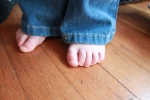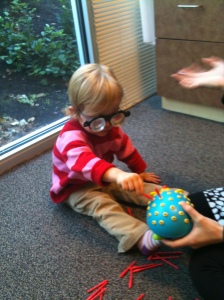Happy Stella progresses with yoked prism goggles and vision therapy
As spring arrived, Stella turned a corner and found herself in a sunnier place. I’m soaking it up, people.
All of a sudden, she seems more social. Of course she’s still shy in some situations, but lately, nothing really seems out of the ordinary for her age. At the playground last week, she complimented an 24-month-old-ish boy on his jacket, pants and shoes. And just between you and me, they were nothing special so you know she was being extra sweet and friendly. (The kid looked back at her and said, “I’m tall.”) The kicker occurred last night when she collaborated with her best buddy and longstanding weekly playdate on an imaginary meal, using her play kitchen set and some dried beans and dry uncooked pasta. They collaborated for at least half an hour and afterward I offered to fund their start-up catering business. They worked as a true team, such that Cody and I felt totally inadequate by comparison. Seasoning with salt and pepper, providing Cody and me with plates and everything we needed to properly enjoy their feast, blowing on our food so it wasn’t too hot, and more–they were on top of everything and both contributed equally and without conflict. She said, “Okay, dinner’s ready!” inflecting just as I do. Her friend took the pan out of the oven only to pronounce, “It needs a few more minutes.” No problem! They both went back to adjust the heat, open the oven, season it again, etc. They’ve always gotten along but there is a whole new level of interaction going on now. All around, Stella’s opening up to new people and new situations. Coincidentally, my shoulders are more relaxed. I’m probably more social, and less worried, too.
She’s growing so tall, that some 3T clothing is too short (to be exact without using the much-maligned months method of age accounting, she’s 2 and 2/3). Her language has undergone its own growth spurt, such that her sentences are suddenly more fleshed out and descriptive and specific. Less toddler-ese, more kid-ish. New molars have just broken through. She’s having fun with her new/first babysitter–adjusting to the situation much more quickly and happily than I dared dream. At-home vision therapy has been pretty darn smooth. Without really looking for this, I’ve noticed her new comfort with catching and hitting a balloon from above. Not long ago, she avoided this like H1N1 and now does it on her own, just for kicks. You know, tossing it up as high as she can and then catching or hitting it up there again. I’ve been very impressed and encouraged. Stella is thriving and woven in with her development, I see the benefits of vision therapy.
Up at the office, Alderwood Vision Therapy Center (for the record, we are paying clients and not being paid to promote them–so be cool, be cool), she’s been much more agreeable and engaged. I’m sure her recent developmental gains have something to do with it, but much credit goes to our vision therapist, Bethanie, for suggesting that we move the in-office therapy later in the day. It has made a remarkable difference. Later is so clearly better that we all agreed to cancel our standing morning slot and take whatever later time comes up each week. No later slots are open, so we have to hope for a cancellation. If nothing comes up, they told us to just skip it instead of taking our old time. That should tell you how rocky it was in the morning. What a relief! I felt like cracking open a bottle of Veuve Clicquot then and there, and toasting the end of a decidedly cranky era.
For a few sessions now, Stella’s been wearing the yoked prism goggles for 30+ minutes at a time! Walking across balance beams, making bead necklaces following a pattern, catching and bouncing balls, and jumping on trampolines while identifying letters or colors on a chart. All that and a lot more, while wearing those goggles. It used to be a challenge to get her to wear them for five minutes.
Though, I’ll admit it’s getting a bit trickier. Stella has shown that she likes and will tolerate the goggles in the base down position, so we need to switch things up on her. The goal is for Stella’s brain to learn to adjust to the input from the goggles–regardless of the lenses’ position. Stella will be done with them when, no matter where the lenses are pointed, she’s comfortable and not thrown for a loop. A couple appointments ago, after a long stretch with the lenses base down, Bethanie switched them to be base up. As if we’d flipped a switch, Stella’s whole demeanor and attitude crashed immediately. It upset her deeply. She became a different person! These are difficult moments for both of us. I struggle with them emotionally, but also find large clues about Stella’s vision.
When the goggles are base down, notorious toe-walker Stella walks flat–the stronger the prisms, the more pronounced the effect. Base down, which she so clearly prefers as made obvious by her cheerful demeanor, her peripheral vision is greatly amplified. In one exercise, letter puzzle pieces were scattered all over the office floor. Wearing the base-down goggles, Stella scanned the floor and found letters as they were called out by Bethanie, then placed them in the puzzle. I noticed that Stella was finding letters to her side–without having to look directly at them! With her searching gaze directed in front of her, she identified and found letters off to her side. So subtle, yet incredible.
After Stella’s brain has had time to adjust to the base-down position, Bethanie now switches them to the base-up position, which (at least in my experience trying the goggles on) lifts and tightens the visual field. It limited my peripheral vision. While not upsetting to me, it felt a bit like being in a tunnel. After the change, Stella’s brain is forced to adapt–to figure out for itself how to map out the periphery. This is HARD for Stella. Which is why I’m so proud of the progress she made in only two sessions. The first time Bethanie went from base-down to base-up, as I explained above, Stella completely freaked out and wanted them OFF. She did wear them for a couple of minutes that time, doing a familiar stacking puzzle in a secluded corner. We realized she was averse to being in the open with the base-up lenses, she wanted to be lower to the ground, and near tasks were more tolerable. In essence, she preferred places and activities that felt more secure, to counter the insecure feeling imparted by the base-up goggles. We didn’t push her, and moved on quickly. But those few moments were telling, and there was even some therapeutic benefit derived. Because the next time, her reaction was less explosive. While still showing dislike of the base-up position, she tolerated it longer and walked across the balance beam a few times! This is how vision therapy moves forward, step by step, over layers of small revelations. And in Stella’s case, mouse sticker after flower sticker, like stepping stones in a river of chocolate milk. Yes, completely unpoetic, but for toddlers, tiny rewards hold epic sway. And honestly, Stella earns them.
Speaking of sway (“controlling influence” not “middle school slow dancing”), the lure of marbles is very powerful with Stella right now, and I casually mentioned this to Bethanie. We paint with them, and play all manner of rolling games with them. So during that second base-down to base-up experience, she invited Stella to collect a marble from me on one end of the beam and walk on the beam to the other side and deliver it to a Frisbee Bethanie held, which she would then move so the marbles raced around the edge. Stella did so a few times before bailing and removing the goggles. Again, the time before, Stella wouldn’t go near the balance beam with base-up lenses, and would instead throw herself on the ground and rip off the goggles pronto. I’m going to start taping segments of her therapy and at the end, put together the most inspiring montage since Rocky. I’m taking soundtrack suggestions, so please do chime in.
Because it’s still a challenge, and because the goggles are proving to be powerful and beneficial for Stella, Dr. Torgerson is arranging for a pair of yoked prism goggles for us to check out and use at home. Holla! I’m thrilled. This is going to be good for Stella, as we can take some of the pressure off. She can wear them here and there, as opposed to having all hopes resting on the in-office goggle work. Bethanie and I will work together figure out how to make this process as comfortable yet potent as possible. Hey, so maybe Cooper and Stella aren’t the only dynamic duo in town. Though, Stella is turning out to be one hell of a teammate. She and I may take the collaboratively baked cake, if I do say so myself.
You know, spring is here, but Stella’s been so delightful I hardly noticed.

